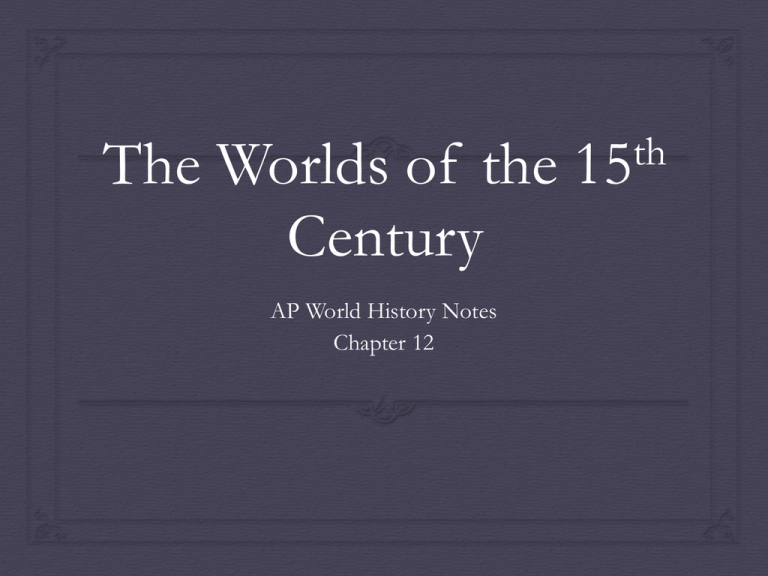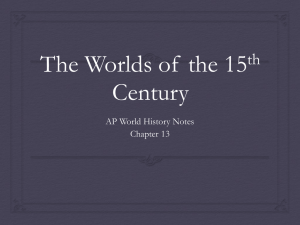The Worlds of the 15th Century
advertisement

The Worlds of the Century AP World History Notes Chapter 12 th 15 Paleolithic Persistence Paleolithic (old stone-age) peoples still existed in the 15th century Hunting and gathering societies Where? Australia, much of Siberia, the arctic coastlands, and parts of Africa and the Americas Agricultural Village Societies Small village-based communities organized by kinship relations Agricultural No incorporation into larger empires or civilizations Where? much of North America, parts of the Amazon River basin, Southeast Asia, and Africa south of the equator Agricultural Village Societies No oppressive political authority No class inequalities No seclusion of women The Igbo peoples of West Africa Herding Peoples Nomadic pastoral peoples Had more direct and dramatic contact with larger civilizations than agricultural village societies or hunter-gatherers Where? Central Asia/the steppe, parts of Africa Arguably the most significant = the Mongols Timur Turkic warrior who tried to restore the Mongol Empire in the late 14th & early 15th centuries Devastation once again to Russia, Persia, and India Died (in 1405) while preparing an invasion of China Empire didn’t last conflict among his successors Last great military success of Central Asian nomads Ming China (1368-1644) Rebuilt strong central government Reinstated civil service examinations and made them even harder Increase in food and trade production Increase in population Ming China Capital = Beijing Emperor Yongle built the Forbidden City = magnificent imperial residence Also built the Temple of Heaven = where rulers performed Confucian-based rituals to ensure the wellbeing of Chinese society Ming China Focus = repairing the damage caused by Mongol rule Restored millions of acres of cultivation Rebuilt: canals, reservoirs, and irrigation systems Planted millions of trees to reforest China Chinese Exploration China undertook large and impressive maritime expeditions Largest = launched in 1405 and led by Zheng He 300 ships; 27,000 crew members; variety of different people on board He made 7 voyages between 1405 and 1433 Voyages of Zheng He Chinese Exploration Goals of Chinese exploration: Enroll distant peoples and states in the Chinese tribute system Bring back exotic goods from foreign lands (ex: zebras, giraffes, etc.) Establish Chinese power and prestige in the Indian Ocean Exert Chinese control over foreign trade Chinese Exploration Abrupt and deliberate end to Chinese exploration in 1433 WHY? Death of Emperor Yongle = chief supporter Many officials saw expeditions as a waste of money and resources Believed focus should be on real threat = nomads to the north







